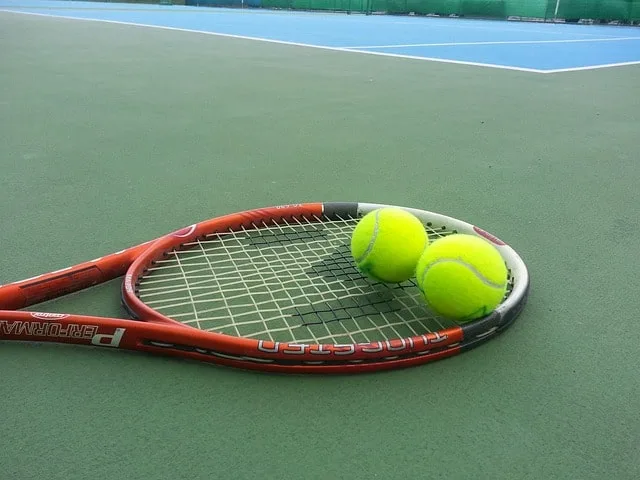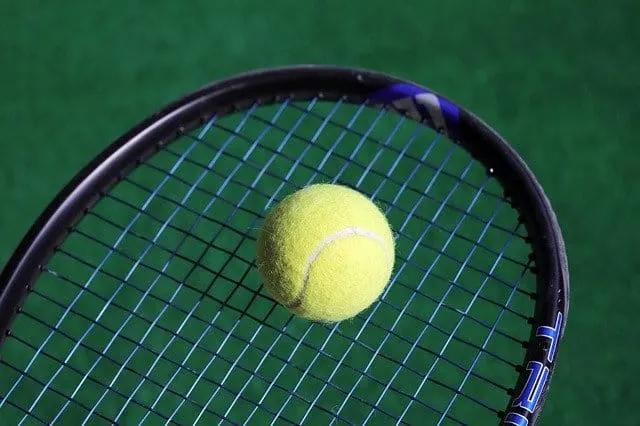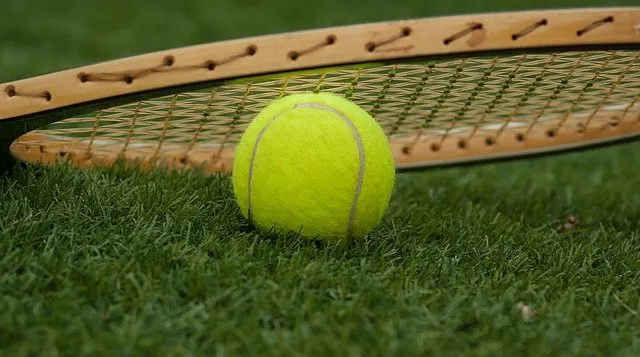
It’s fair to say a lot of tennis players, in their quest for improvement and progression, spend time researching tennis rackets to find the right one for their game.
Some are loyal to particular brands, but it’s important to choose one which is a comfortable weight, and the right sized head to give you sufficient control and power.
What’s often overlooked is the balance of the tennis racket.
In this guide, let’s define what tennis racket balance means, how you measure it and why it’s important for your game.
What is tennis racket balance?
This essentially means how the weight of the racket is spread around the racket.
Some rackets have more weight in the head, and less in the handle. These are known as head heavy rackets.
Other rackets have more weight in the handle and less in the head. These are known as head light rackets.
Also, some rackets can be evenly balanced with an equal amount of weight in the head and the handle, but this is quite rare.
Most rackets are either head heavy or head light so the balance point of the racket will slightly lean towards the head or handle.
How do you measure tennis racket balance?

You can measure tennis racket balance using either of the following 2 methods:
- Using the term “points head light” or “points head heavy” with a preceding number.
- Using millimetres or centimetres (measured from the butt of the racket)
Describing rackets as being points head heavy or head light is more common in the US, where as in Europe, racket balance is measured in millimetres or centimetres.
Using points
Each point is calculated as 1/8” from the midpoint of the racket moving towards the head or towards the handle.
Standard tennis rackets are usually 27” long.
That means the midpoint is 13.5” from either end of the racket.
Let’s look at a couple of examples:
Example 1
If a racket is classed as 4 points head light, it means the balance point is 13” from the bottom of the grip, or 14” from the tip of the racket. It can be classed as head light as there is slightly more weight in the handle than in the head.
Example 2
If a racket is 4 points head heavy, the balance point is 14” from the bottom of the grip, or 13” from the tip of the racket. The racket head will be slightly heavier than the handle.
Using millimetres or centimetres
The alternative way to calculate the balance of a tennis racket is to measure from the butt of the racket to the balance point in millimetres or centimetres. A typical racket is 685.8mm long so the midpoint is 343mm from either end.
Example 1
If a racket has a balance of 315mm it can be classed as being head light, as it less than 343mm with slightly more weight in the handle.
Example 2
If racket has a balance of 360mm it can be classed as being head heavy. The balance point is past the midpoint, when measured from the butt of the racket, and therefore there is less weight in the handle and more in the head.
Tennis racquet balance point calculator
If you want to calculate the balance of your tennis racket, you can work it out by balancing it in the middle and then gradually moving it either side by 1/8” (1 point) to work out how many points head light or head heavy it is.
You can do this on a table, on a tennis net, or there are machines which can work it out for you
If you want to convert your tennis racket balance from points head light/head heavy to millimetres or centimetres you just need to do some basic math.
- 1 inch is 2.54 cm.
- Therefore if one point is 1/8 of an inch, one point = 0.3175cm (or 3.175mm)
- If you know the midpoint of the racket is 13.5” (or 343mm) measured from the butt of the racket, you can just work things out from there.
For example, let’s say a racket is 4 points HL and you want to know what this is in millimetres:
- 4 points head light is (1/8 *4) = half an inch.
- Half a inch = 1.27cm or 12.7 mm
- Head light means the balance point will be slightly towards the handle
- 343mm-12.7mm = 330mm
You could also flip things round and calculate the number of points based on the balance point.
For example, my Mantis Pro 295 III has a balance of 325mm. I have no idea what it is in terms of points. I just know it is head light.
Let’s work it out.
- It is 27” long, so the midpoint is 13.5” or at 343mm from either end of the racket.
- 343mm-325mm = 18mm
- One point is 3.175mm. So my racket is 18mm/3.175mm = 5.5 points HL (approximately)
If you’d rather have something to refer to, without the need to calculate or convert anything, here is a tennis racket balance chart below which has everything you need (assuming you’re using the standard racket length of 27″).
Chart – Tennis racket balance
| Points | Inches | Millimeters |
|---|---|---|
| 10 Points HH | 14.75 (+1.250) | 375 |
| 9 Points HH | 14.625 (+1.125) | 371 |
| 8 Points HH | 14.5 (+1) | 368 |
| 7 Points HH | 14.375 (+0.875) | 365 |
| 6 Points HH | 14.25 (+0.75) | 362 |
| 5 Points HH | 14.125 (+0.625) | 359 |
| 4 Points HH | 14 (+0.5) | 355 |
| 3 Points HH | 13.875 (+0.375) | 352 |
| 2 Points HH | 13.75 (+0.250) | 349 |
| 1 Point HH | 13.625 (+0.125) | 346 |
| 0 Point HH (Even) | 13.5 | 343 |
| 1 Point HL | 13.375 (-0.125) | 340 |
| 2 Points HL | 13.25 (-0.250) | 337 |
| 3 Points HL | 13.125 (-0.375) | 333 |
| 4 Points HL | 13 (-0.5) | 330 |
| 5 Points HL | 12.875 (-0.625) | 327 |
| 6 Points HL | 12.75 (-0.75) | 324 |
| 7 Points HL | 12.625 (-0.875) | 321 |
| 8 Points HL | 12.5 (-1) | 318 |
| 9 Points HL | 12.375 (-1.125) | 314 |
| 10 Points HL | 12.25 (-1.250) | 311 |
| 11 Points HL | 12.125 (-1.375) | 308 |
| 12 Points HL | 12 (-1.5) | 305 |
Chart – Most popular tennis racket balances
Most rackets are head light, and you find most are between 4-10 points head light.
Here’s a poll over at Tennis Warehouse showing that 7-8 points head light is the most popular option among the forum members.

Head Light vs Head Heavy vs Evenly Balanced – What’s the difference?
Having a racket with a heavier head, or lighter head obviously has a big impact on your game in terms of your control and power.
Head light rackets tend to be heavier overall, whereas head heavy tennis rackets are generally lighter.
Evenly balanced rackets have the weight distributed evenly throughout the frame so the balance point will be exactly in the middle.
Let’s take a look at the advantages and disadvantages of all 3 options.
Pros of a head light racket
As mentioned above, the majority of rackets are head light.
This is because for tennis players who have been playing a while, head light rackets are easier to swing, with more control and you get more maneuverability which is great when you are at the net for volleys.
You can also react to shots quicker if an incoming shot is traveling at pace. Furthermore, as the frames for head light rackets are generally heavier, it also gives you a bit more stability on your shots.
A head light racket is generally ideal for intermediate and advanced players.
Cons of head light racket
The main drawback of head light rackets is you get less power on your shots. You have to swing with more force and generate more of your own power as you swing.
Although this gives you more control, you have to ensure you have a solid full swing and good timing on your groundstrokes otherwise you can hit a lot of unforced errors.
Head light rackets generally have smaller head sizes, which means a smaller sweet spot, so you need to hit your shots with a lot of precision otherwise you’ll hit the frame more often.
Furthermore, as head light rackets tend to be heavier frames overall, you need to be in better shape physically as your arm and shoulder can get more tired during a match.
Example of a head light racket
If you want an example of a head light racket, why not take a look at Roger Federer’s racket of choice. The Wilson Pro Staff RF97 Autograph is 9 points head light and it will give you lots of control, but the frame is a touch on the heavy side.


Pros of head heavy racket
Head-heavy rackets are generally better suited to beginners, some senior players, or anyone who either hasn’t developed a solid tennis swing yet, or struggles generating power on their shots.
As more of the weight is towards the head, it means the racket head can be bigger. This is great for beginners as it gives you a larger sweet spot to make a better connection with the ball, and it provides players with more power.
Head heavy rackets tend to have lighter frames to compensate for the heavier head which makes it a little easier to swing.
Cons of a head heavy racket
Although you get more power with a head-heavy racket, the main thing you sacrifice is control. It’s a lot harder to control how hard to hit your shots from the baseline, as well as softer shots in and around the net.
The lighter frame is great if don’t have a strong physique as it makes the racket easier to swing. However, you get less stability which means it’s harder to deal with shots coming at you with a lot of paces.
Example of a head heavy racket
The Head Graphene 360 Instinct PWR is a great choice if you’re a beginner who wants lots of power from the baseline and a bit more juice on your serves. It’s a whopping 10 points head heavy!


Evenly balanced rackets
Evenly balanced rackets should offer you a nice blend of control, stability, and power.
However, you are not really benefiting in any particular area. With this type of racket balance, you won’t get many advantages playing at the net, or for reacting to shots coming at you with a lot of speed. Also, at the baseline, you won’t generate as much power as a head-heavy racket, and your arm may still get tired during the match with all the repeated swings.
It might work for some players, but overall I still feel head light is the way to go as your technique improves and you progress as a tennis player.
Example of an evenly balanced racket
The Babolat Pure Aero Lite is an evenly balanced tennis racket, and it’s a great option if you put lots of spin on your shots.

Can you change your tennis racket balance?
Yes. Plenty of players prefer a bit more weight in the head of their racket to provide more power in their shots. You can achieve this by applying some lead tape around the head.
This strategy is quite common for intermediate/advanced tennis players who like playing a lot from the baseline.
If you place it at the top of the racket, this can help create more power.
If you attach some lead tape to the sides of the head, this can create a little more stability.
Although it’s less common, some players prefer to add some more weight to the handle. You might do this to create a more equal balance if you’re already attached lead tape to the head, or simply to give you more stability on your shots.

What is a balance board?
These are devices that can be used to measure where the balance point is on your “head-heavy” or “head light” racket. Such a purchase is only worthwhile if you’re thinking of tweaking your balance point by adding lead tape to the head or handle.
The Alpha Viper Balance Beam is quite a popular choice that will do exactly what you need.
What balance do the pros use for their rackets?
Unless you physically have access to the exact racket a tennis pro uses, it’s impossible to know for sure.
We know the vast majority have head light rackets, as pro players want more control and they can generate a lot of power by themselves.
However, a few may lean towards a more even balance, or a head-heavy racket. This suits baseliners who really want a lot of power in their shots. Carlos Moya apparently used a racket that was 7 points head heavy!
